![]()
Tue, Dec 18, 2012 | terrorism-info.org.il
Appendix III — Hezbollah’s Terrorist Activities during the 1980s
Hezbollah has a 30-year history of terrorist activity in Lebanon, the Middle East and around the globe, directed against Israel, the Jewish people, the United States and the West, pro-Western Arab states and Hezbollah’s enemies in Lebanon. This study is published by The Meir Amit Intelligence and Terrorism Information Center. You can download the full study in PDF format here.
Overview
Hezbollah’s terrorist activity during the first years of its existence focused on the United States and France, the main targets of a wave of terrorist attacks in Lebanon and elsewhere. Later, Hezbollah waged guerilla warfare against the IDF in Lebanon, beginning with the bombing of the IDF headquarters in Tyre in 1983. The most notable operations in the anti-Western terrorist campaign were the bombing of the United States embassy in Lebanon, the bombing of the United States and French military barracks in Beirut, abductions and murders of Western figures in Lebanon, and the hijacking of a TWA flight en route from Athens to Rome.
Hezbollah’s terrorist attacks were part of an Iranian terrorist campaign waged to promote Iran’s political and strategic objectives. Some of its objectives were to undermine the influence of Western countries and Israel in Lebanon and keep France from assisting Iraq during the Iran-Iraq War. Some of Hezbollah’s terrorist operations were intended to obtain hostages to be used to leverage the release of Hezbollah operatives held by Arab and Western countries and by Israel.
Hezbollah’s terrorist campaign led to proxies’ being used by Iran for terrorist activities. It allowed the Iranians to initiate terrorist attacks while denying any involvement in them and to avoid a head-on clash with the United States. The Lebanese Hezbollah, Iran’s leading proxy, also did not claim responsibility for its terrorist attacks and used pseudonyms. Categorical denial of any involvement in terrorist attacks has since become a trademark of both Iran and Hezbollah, even when the evidence for their involvement is solid (such as the AMIA bombing in Argentina).
Politically, it can be said in retrospect that Iran’s terrorist campaign in the 1980s, which focused on the United States and France, had significant achievements: in the short term, the terrorist attacks led to the withdrawal of the multi-national force from Lebanon (February 1984), which had been deployed in Beirut in the summer of 1982 to supervise the withdrawal of the Palestinian forces and maintain peace.[47] The withdrawal of the multi-national force was perceived as an American loss of interest in the developments in Lebanon, and considerably weakened its political influence in the Lebanese arena and the Middle East in general. Consequently, Lebanon’s President Amine Gemayel lost strength and was forced to exchange his pro-Western orientation for a pro-Syrian orientation. The pressure caused by these developments led President Gemayel to cancel the American-brokered Israeli-Lebanese agreement (the May 17 Agreement, 1983), which was strongly condemned by Iran and Syria. France also agreed to make political concessions to Iran on bilateral issues in exchange for an end to the wave of anti-French terrorism.
The collapse of the May 17 Agreement, coupled with the wave of attacks against IDF troops in Lebanon, eventually led to Israel’s unilateral withdrawal from Lebanon without a political agreement (1985). Furthermore, the political and military vacuum left by the IDF’s withdrawal and the collapse of the power of the pro-American and pro-Israeli Lebanese factions was filled by Syria and Iran. Thus, in the mid-1980s a new era began in the internal Lebanese arena, marked by a significant decline in the political influence of the United States, Israel, and the West. On the other hand, Syrian and Iranian influence grew while Hezbollah gradually became the leading military and political power in Lebanon.
From the operative point of view, an analysis of Hezbollah’s methods indicates that it employed two methods which, at the time, became symbols of Iransponsored terrorism: first, using suicide bombers against the United States and its allies, and later against the IDF; second, abducting Western hostages and hijacking airplanes for the release of prisoners, for revenge and for punishment. These two methods became a model for the Palestinian terrorist organizations, which turned suicide bombing terrorism into the weapon of choice in their 2000-2005 campaign of terrorism against Israel (the second intifada).
The Lebanese Arena
Bombing the American Embassy and American and French military Barracks in Beirut (1983)
Two of Hezbollah’s deadliest terrorist attacks were carried out in Lebanon in April and October 1983. They were orchestrated by Iran and executed by Hezbollah, then headed by Imad Mughniyeh, claiming responsibility with the pseudonym “Islamic Jihad”.
- The suicide car bombing of the United States embassy in western Beirut (April 18, 1983). The car was packed with about 900 kg (1980 lbs) of explosives. Sixty-three people were killed in the attack, including 17 Americans, 32 Lebanese employees, and 14 visitors. Nearly 120 people were injured, including United States Ambassador Robert Dillon.
- The attack against the Marine command center and the barracks of the French unit of the multi-national force: a truck carrying 5,450 kilograms (12,015 pounds) of explosives broke through the camp gate, entered the main building and blew up (October 23, 1983).[48] The explosion caused the deaths of 241 American soldiers (including 220 Marines) and 58 French soldiers.
Iran’s Foreign Minister Ali Akbar Velayati denied Iranian involvement in the terrorist attack. However, sensitive intelligence information that leaked (or was leaked) in the United States clearly showed that Iran was behind the terrorist attacks against the United States. This was described in more detail by Dr. Shimon Shapira in his book Hezbollah between Iran and Lebanon:[49]
“Before the headquarters of the multi-national headquarters was hit, the United States National Security Agency (NSA) picked up communications sent from the Iranian Foreign Ministry to the Iranian embassy in Damascus. In them Tehran asked for a massive attack against the Americans, providing the embassy in Damascus with the sum of twenty five thousand dollars. In addition, the NSA picked up telephone conversations in which the Revolutionary Guards in Baalbek asked permission from the Iranian embassy in Damascus to carry out the attack. However, the deciphered communications revealed nothing about the attack’s date, exact target or modus operandi. One week before the attack, Hossein Sheikh al-Islam, one of the closest aides of Iran’s Foreign Minister Velayati, arrived in Damascus and stayed at the Sheraton Hotel. He left the city one day before the operation. On the morning of the explosion, the Iranian embassy in Beirut was evacuated and its personnel were rushed out of the building.”
Courts in the United States found Iran responsible for Hezbollah’s terrorist attack, in which 241 American soldiers were killed in the Beirut command center. Eight verdicts pertaining to the issue ruled that Iran had to pay over $8.8 billion to the victims’ families. The last verdict, dated July 3, 2012, ruled that Iran had to suffer the consequences of supporting terrorism and pay $813 million to the families of the victims (Agence France-Presse, July 7, 2012).
Severe Blow to the Lebanese Branch of the CIA
The 17 Americans who died in the embassy included nine CIA members and support personnel, including the Beirut station chief. Also killed was Robert Ames, the leading CIA analyst in the Arab world, who was staying at the embassy during a visit to Beirut. It was “the deadliest day in the history of the agency”, says Tim Weiner in his book. “The blast was the work of Imad Mughniyah, supported by Iran.”[50]
Among the Americans abducted was William Buckley, the CIA station chief in Lebanon, abducted in March 1984. On October 3, 1985, his captors claimed that they had killed him. The remains of his body were found in a plastic bag on the way to the Beirut airport in 1991.[51]
The abduction and murder of American intelligence personnel during the bombing of the embassy were a severe blow to the capabilities of the American intelligence agency in Lebanon and elsewhere. According to Tim Weiner:
“As the CIA fought to rebuild in Beirut, it did not see a new force rising from the rubble. An assassin named Imad Mughniyeh, a chieftain of the violent terrorist group called Hezbollah, the Party of God, was gathering money and explosives, training his thugs for a series of bombings and kidnappings that would paralyze the United States for years to come. He reported to Tehran, where the Ayatollah Khomeini was creating an Office of Liberation Movements to further his messianic vision of conquering Iraq… Mughniyah’s name has been forgotten now, but he was the Osama bin Laden of the 1980s… The obliteration of the Beirut station and the death of Robert Ames destroyed the agency’s capability for gathering information in Lebanon and in much of the Middle East.”[52]
Abducting Western Nationals
Overview
Another type of terrorist attack carried out in Lebanon in the 1980s, mainly by Hezbollah, was the abduction of Western nationals for punishment, intimidation and bargaining, intended to advance Iran’s interests and free detained terrorists. In the ten years between 1982 and 1992, 96 foreign nationals from 21 countries were abducted in Lebanon: 25 Americans, 16 French, 12 English, 7 Swiss, and 7 West Germans (Wikipedia). Most of the captives were innocent civilians who lived and worked in Lebanon, such as journalists, lecturers in higher education institutions (particularly the American University of Beirut), and humanitarian activists. Some of them were United States administration officials from other Western countries.
The abduction of the Western nationals was part of an overall Iranian strategy of making extensive use of terrorism for political gain and strategic gain. Most of the captives were released shortly after being abducted, but others were held in captivity for weeks, months and even years. Some of them were murdered by their captors. Hezbollah was responsible for most of the abductions, which were intended to advance the interests of Iran as well as those of Hezbollah itself. The abductions were carried out under such pseudonyms as Islamic Jihad, the Revolutionary Justice Organization, and the Organization of the Oppressed on Earth. When Iranian policy changed in the late 1980s, the wave of abductions stopped.
Information about some of the abductees (according to Wikipedia and other sources):
- David Dodge: United States citizen, president of the American University of Beirut. Abducted in July 1982 and released on July 21, 1983. While in captivity he was transferred to Iran, where he was interrogated about his connections with the United States administration.
- Frank Regier: United States citizen, lecturer at the American University of Beirut. Lived in Lebanon for 27 years. Abducted on February 11, 1984 and released in April of the same year.
- Benjamin Weir: United States citizen. He and his wife were missionaries for the Presbyterian Church. Abducted in May 1984 in Beirut. Freed one year and four months later.
- Peter Kilburn: United States citizen, librarian at the American University of Beirut. Abducted on December 3, 1984, about one month before his retirement. He was murdered by his captors. His body was found in April 1986 and brought back to the United States for burial.
- Eric Wehrli: Swiss diplomat, served in western Beirut. Abducted on January 3, 1985. Freed on January 8 by activists belonging to the Amal movement. The Amal activists claimed that they had identified some of Wehrli’s captors as relatives of a Hezbollah operative who was detained at the Zurich airport on December 18, 1984.[53]
- Lawrence Jenco: American priest, director of the Catholic welfare services in Beirut. Abducted on his way to work on January 8, 1985. Freed on July 26, 1986.
- Geoffrey Nash and Brian Lebick: two British subjects abducted in western Beirut. They were released shortly thereafter.
- Terry A. Anderson: United States citizen, reporter on Middle Eastern affairs for AP. Abducted in Beirut on March 16, 1985, freed on December 4, 1991; moved from place to place while in captivity.
- Jean Paul Kaufmann: French journalist, worked for Agence France-Presse in Beirut. Abducted on May 22, 1985 and freed three years later. Abducted at the same time was French sociologist Michel Seurat, who was conducting research on Shi’ite Islam in Beirut. In addition, three staff members of the French embassy in Beirut were abducted in March 1985. They were freed in November 1986.
- David Jacobsen: United States citizen, director of the hospital of the American University of Beirut. Abducted in May 1985 and released on November 2, 1986.
- Marcel Coudry: French businessman who lived in Beirut. Abducted on March 3, 1986, with four crew members of the France-2 TV channel. They were released on June 20, 1986.
- John McCarthy: British citizen, reporter for CBE. Abducted on April 16 with Brian Keenan, from Ireland, also a reporter for CBE. McCarthy was freed on August 8, 1991. Kennan was freed by the Syrian army on August 24, 1990 and transferred to Damascus.
- John Douglas and Philip Padfield: two British subjects who worked for the American University of Beirut. Their bodies were found in April 1986.
- Frank Reed: United States citizen, director of the International School of Lebanon. Abducted on July 26, 1986 and freed in May 1990.
- Joseph Ciccipio: United States citizen, worked for the American University of Beirut. Abducted on September 12, 1986 and freed in 1991.
- Edward Tracy: United States citizen, author. Abducted on October 21, 1986 and released in August 1991.
- Alan Steen, Jesse Turner, Robert Polhill: three Americans, abducted on January 24, 1987. Two of them taught at the American College in western Beirut, the third was a lecturer on business management at the American University of Beirut. They were abducted with an Indian citizen. Polhill was freed in 1991.
- Alfred Schmidt and Rudolph Cordes: two businessmen from West Germany. Abducted in January 1987 and held hostage for the release of Muhammad Ali Hammadi, a Hezbollah operative held in Germany.
- Roger Auque: French citizen, journalist, abducted on January 14, 1987. Freed on November 28 of the same year.
- Terry Waite: British subject, human rights activist, author. Mediated the release of captives in Lebanon on behalf of the Anglican Church. Abducted on January 20, 1987 while on a mediating mission. Freed on November 18, 1991.
- Charles Glass: United States citizen, TV reporter. Studied at the American University of Beirut and lived there for six years. Abducted on June 17, 1987.
- Jackie Mann: British subject, served as Chief Pilot with Middle Eastern Airlines, Lebanon’s national carrier. Abducted in May 1989 and freed on September 24, 1991.
- Emanuel Christen and Elio Erriquez: two Swiss nationals abducted in Sidon on October 6, 1989 while on a humanitarian mission for the Red Cross. They were freed ten months later.
- Jeremy Levin: the CNN bureau chief in Beirut. He was abducted on March 27, 1984 and escaped from captivity in the Beqaa Valley on January 14, 1985.
Another top United States official who was abducted and murdered was Colonel William Higgins, chief of the United Nations Truce Supervision Organization (UNTSCO) in south Lebanon. He was abducted in February 1988, tortured and murdered by his Hezbollah captors.
Assassination of Western and Jewish Figures
Overview
Some of the Western hostages abducted by Hezbollah were murdered by their captors. In several cases their bodies were found and sent back to their home countries. The following are two examples of high-ranking Westerners who were stationed in Beirut and were killed in attacks carried out by Hezbollah:
Murdering the French Military Attaché in Lebanon (1986)
On September 18, 1986, Christian Gouttière, the French military attaché in Lebanon, was murdered by Hezbollah. Hezbollah operative Hussein Mustafa Tleis, a Shi’ite Muslim from the Beqaa Valley, participated in the murder. Terrorists armed with silencer-equipped pistols fired three shots into Colonel Gouttière’s head after he parked his car outside the French embassy compound in the eastern Beirut neighborhood of Hazmieh. After the murder, one of the Western news agencies in the city was called by an anonymous individual who claimed responsibility on behalf of a non-existent organization called the Justice and Vengeance Front. The caller also insinuated that the murder was part of the wave of killings that had taken place in Paris that year (UPI, Beirut, September 18, 1986).[54]
During his trial and the appeal against the verdict, Tleis admitted to murdering Gouttière. He said that he had belonged to Hezbollah since 1982 and had been carrying out Hezbollah’s orders. According to Tleis, the murder was in retaliation for the 1983 French Air Force attack on the Hezbollah stronghold in Baalbek, Lebanon Valley. Tleis admitted that he was involved in a car bombing in northern Beirut and in planning to assassinate Camille Chamoun, Lebanon’s former president and the Christian camp leader (AP Beirut, February 25, 1998).
In 1994 Hussein Tleis was found guilty by a military court in Lebanon, which sentenced him to death. He was pardoned under the general amnesty granted to perpetrators of political crimes during the Lebanese civil war. His death sentence was commuted to a lifetime sentence. In 1998 Hussein Tleis escaped from the Roumieh Prison infirmary, where he was brought due to an illness (arabicnews.com, AP, February 25, 1998).
Murdering the President of the American University of Beirut (1984)[55]
On January 18, 1984, Malcolm H. Kerr, the President of the American University of Beirut, was shot in the back of the head as he approached his office. The killers were two young men who fled the scene and were never identified. The assassination followed the modus operandi of murdering and abducting Western nationals, a tactic which Hezbollah employed in the 1980s at Iran’s bidding. The lecturers and staff of the American University of Beirut, perceived by Iran and Hezbollah as a symbol of Western culture, became favorite targets for abduction and murder.
Malcolm Kerr was born in Beirut in 1931 to American parents. He grew up near the American University of Beirut and studied at Princeton University. His first teaching job was at the American University of Beirut, where he taught at the department of Political Science for three years. He subsequently taught at UCLA. Kerr was considered an expert on the politics of the Middle East. One of his well-known books is The Arab Cold War, Gamal ‘Abd Al-Nasir and His Rivals (1958-1970).
In March 1982, after a twenty-year academic career at UCLA, Kerr returned to Beirut. In the same month he was appointed president of the American University of Beirut. The University continued functioning for two years despite the dramatic events taking place in Lebanon at the time (the civil war, the IDF siege on Beirut, the terrorist attacks on American targets in Beirut in 1983) until the morning of January 18, 1984, when Kerr was assassinated.
In 2002 Malcolm Kerr’s widow, children and sister filed a lawsuit in America against Iran and Iran’s Ministry of Intelligence and Security (MOIS)[56] for their role in the assassination. The court was given evidence that Hezbollah had carried out the assassination using the pseudonym Islamic Jihad with the logistical and financial support of Iran and the MOIS. The court heard the testimonies of the United States ambassador to Lebanon at the time and American intelligence officials. The court found Iran responsible for the assassination of Malcolm Kerr, carried out by Hezbollah, and entered a judgment against Iran for compensatory damage to the victim’s family.
Kidnapping and Abducting Jews (1985)
After the IDF withdrew from Lebanon in 1985, Hezbollah carried out a wave of abductions of Lebanese Jews from families that had lived in Lebanon for generations. About half of the captives were over the age of fifty. They were executed several months after being abducted. As usual, Hezbollah did not claim responsibility but hid behind a pseudonym of the Organization of the Oppressed on Earth.
The abductions began in late March 1985 in Wadi Abu Jamil, the Jewish quarter of western Beirut. Eight Jews were abducted simultaneously in a carefully planned operation, including Isaac Sasson, leader of the Jewish community, and Dr. Elie Hallaq, the community physician. The captors demanded the release of hundreds of Lebanese detainees held in Israel and in the South Lebanese Army’s Al-Khiyam detention facility. When their demands were not met the hostages were executed one by one. Some were buried at the Jewish cemetery in eastern Beirut; the other bodies were never found.
Epilogue
In the late 1980s, after the Iran-Iraq War, the wave of terrorism launched at Iran’s bidding came to a halt. For Iran, having Hezbollah hold Western hostages in Lebanon went from being an asset that occasionally proved itself to a liability for the Imam Khomeini’s successors, particularly President Rafsanjani. This was evident in Rafsanjani’s policy of its serving Iran’s interests to look for ways to approach the West and present a “smiling face” to the international community.
Once Iranian policy changed, Hezbollah’s wave of abductions stopped and within several months all the hostages held in Lebanon were released. Furthermore, after 1990, Hezbollah’s terrorist apparatuses no longer abducted foreign nationals in Lebanon. To paraphrase Shimon Shapira in his book Hezbollah between Iran and Lebanon,[57] the violence was quelled by the hand that had unleashed it. In addition, the Syrians also wanted to stop the abductions and release the hostages as they completed their takeover of Lebanon after the withdrawal of the IDF.
The International Arena
Attacks on the American and French Embassies in Kuwait (1983)
On December 12, 1983, eight months after the attack on the United States embassy in Beirut, the embassies of the United States and France in Kuwait were hit by a wave of terrorist attacks, as were Kuwaiti targets. Orchestrated by the Iranian Islamic Revolutionary Guards, the attacks were carried out by Hezbollah using the methods employed in Lebanon. As usual, Hezbollah did not claim responsibility for the attacks (which were attributed, among others, to the “Islamic Jihad,” one of Hezbollah’s operational pseudonyms).
Details of the attacks:
- On December 12, 1983, a van carrying 45 kg (99 lbs) of gas attached to plastic explosives broke through the front gate of the United States embassy in Kuwait. The van sped toward the three-story embassy building and blew up, demolishing half of the building and killing five people: two Kuwaitis, two Palestinians, and one Syrian (AP, January 1, 1983).
- Approximately one hour after the attack a bomb went off in a car parked near the French embassy building. The explosion blew a hole in the embassy’s security wall. Five people were injured (AP, January 1, 1983).
- At around the same time, more car bombings struck Kuwaiti and Western targets in Kuwait City.
- A van packed with explosives blew up about 150 m (about 490 feet) from a refinery and just several feet away from a site where chemicals were stored.
- Another car blew up at the control tower of the Kuwait international airport. American citizens lived near the explosion site and worked at a factory for an American company that delivered missile systems to Kuwait. One Egyptian technician was killed.
In his book Hezbollah between Iran and Lebanon, Dr. Shimon Shapira, relying on Professor Martin Kramer, divided the objectives of Iranian and Hezbollah terrorist activity at the time into several categories. In his view, the bombings of the United States and French embassies in Beirut were operations carried out to help Iran in its war against Iraq, more specifically, to force the ruler of Kuwait to stop supporting Iraq (the 1984 attempted assassination of the Kuwaiti emir was presumably carried out for the same purpose). The series of bombings in Paris in 1986 can also be considered signals to the French government to abandon its policy of selling weapons to Iraq (see below).[58]
Attempted Assassination of the Emir of Kuwait (1985)
In mid-1985, an attempt was foiled to assassinate the Kuwaiti emir Sheikh Jaber al-Ahmad al-Sabah. The commander of the assassination was Hezbollah operative Mustafa Badr al-Din, Imad Mughniyeh’s brother-in-law. Twenty years later, Mustafa Badr al-Din played a key role in the murder of Lebanon’s PM Rafiq Hariri (Mustafa Badr al-Din is supposed to stand trial before the international tribunal investigating Hariri’s murder).
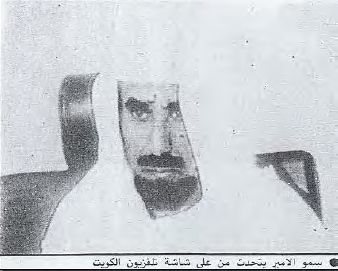
Photograph from the Kuwaiti newspaper Al-Qabas: Sheikh Jaber al-Ahmad al-Sabah, the emir of Kuwait, in his first TV appearance after the attempted assassination (Hewarona.com website)
After the terrorist attacks on the embassies of the United States and France and the Kuwaiti targets, Mustafa Badr al-Din and 17 other Hezbollah operatives or collaborators were detained in Kuwait. Mustafa Badr al-Din was sentenced to death, but the execution of his sentence was deferred. Meanwhile, Hezbollah made an effort to release him and the other Hezbollah operatives held in Kuwait by hijacking airplanes for bargaining, including the hijacking of the TWA plane in 1985 and Kuwaiti planes in 1984 and 1988.
Hijacking Planes
Overview
In the 1980s Hezbollah, with Iranian assistance, carried out several airplane hijackings. Between 1982 and 1988, ten planes were hijacked by Shi’ite operatives,[59] most of whom, in our assessment, were members of Hezbollah. The hijackings served Iranian interests, particularly in the context of the Iran-Iraq War, and were also intended to free Hezbollah operatives detained in Israel, Kuwait, France and other countries. The hijackings were masterminded by Imad Mughniyeh. The following are details of some of the major hijackings:
Hijacking a TWA Flight 847 (1985)
On June 14, 1985, TWA flight 847, a Boeing 727 en route from Athens to Rome, was hijacked by Hezbollah operatives using the pseudonym Islamic Jihad. Three operatives, Imad Mughniyeh, Hassan Izz al-Din, and Mohammed Ali Hammadi boarded the flight in Athens and smuggled guns and hand grenades on. Another operative, Ali Atwa, was not allowed to board. He was detained by the Greek police (he was later released as part of the deal that ended the hijacking incident). While the plane was in Beirut, 12 more operatives joined those who had boarded in Athens.
Having taken over the plane, the hijackers diverted it to the Beirut airport, where it was refueled, continued on to Algiers, headed back to Beirut, returned to Algiers, and returned to Beirut for a third time. During the second stop in Beirut, the Hezbollah operatives murdered Robert Dean Stethem, a United States Navy diver, and dumped his body from the plane onto the ramp.
The hijackers demanded the release of 17 terrorists held in Kuwait jails for their involvement in the 1983 bombing of the United States embassy; one of them was Mustafa Badr al-Din, Mughniyeh’s brother-in-law. They also demanded the release of 766 Lebanese Shi’ites transferred to Israel after the IDF’s withdrawal from Lebanon. About one month after the hijacking, Israel released more than 700 Lebanese detainees, even though it denied any connection between the release and the hijacking.[60]
On October 10, 2001, after the September 11 events, the United States administration put the three TWA hijackers on the FBI’s most wanted terrorists list. A reward of up to $25 million was offered for information leading to the capture or conviction of Imad Mughniyeh.
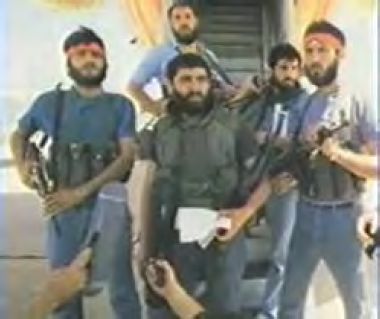
Imad Mughniyeh (center) with other Hezbollah operatives who took part in hijacking TWA flight 847 (YouTube)
Another Hezbollah operative who took part in the hijacking of the TWA flight was Mohammed Ali Hammadi. He was sentenced to prison in Frankfurt in 1987 for attempting to smuggle liquid explosives into Germany. He was charged with the murder of the United States Navy diver during the hijacking and sentenced to life imprisonment. Hammadi was pardoned and released by the German government and returned to Lebanon in 2005. In 2006 the United States formally asked Lebanon to extradite him, but the Lebanese government did not comply.
In 2009 Hammadi went to Afghanistan and joined an Al-Qaeda-affiliated Islamic organization (Jama’at al-Jihad al-Islami) based in Waziristan, Pakistan. According to media reports based on Pakistani intelligence sources, Hammadi was killed in an American drone strike in 2010 (Palday.net/forum).
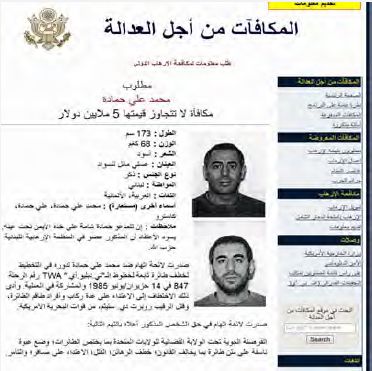
American bulletin in Arabic offering a reward of up to$ 5 million to anyone providing information on Hezbollah operative Mohammed Ali Hammadi (rewardsforjustice.net)
Hijacking Kuwaiti Airplanes (1984, 1988)
On December 3, 1984, a Kuwait Airways flight from Kuwait City to Pakistan was hijacked by four Shi’ite Lebanese who, in our assessment, were Hezbollah operatives. The flight was diverted to Tehran. The hijackers demanded the release of detained terrorists. Two Americans (members of the United States Agency for International Development) were shot during the hijacking. Other American citizens were threatened and tortured.
After six days, Iranian security released the hostages. Some passengers claimed that the hijackers had received weapons and additional equipment during the stay in Iran, including handcuffs to use on the passengers. Even though the Iranian authorities announced that they would bring the hijackers to trial, they were allowed to leave Iran (Pbs.org website).
On April 5, 1988, a Kuwaiti Boeing 747 en route from Bangkok to Kuwait City was hijacked with 111 passengers and crew on board. Three of the passengers were members of the Kuwaiti royal family. The plane was forced to land in Mashhad, Iran. The hijackers, Hezbollah operatives armed with guns and grenades, demanded the release of 17 Hezbollah operatives held in Kuwait. One of the hijackers was Hezbollah operative Hassan Izz al-Din, who had taken part in hijacking the TWA flight in 1985. Sixteen days later the plane took off from Mashhad and made a stop in Larnaka, Cyprus, where two passengers were killed and their bodies were dumped from the plane. The plane then continued to Algiers, where the passengers were set free. The Hezbollah operatives who hijacked the plane were given free passage to Beirut. The 17 prisoners held in Kuwait, including Mustafa Badr al-Din, were not released (but were able to escape from prison after the Iraqi invasion).
Kuwait blamed the hijacking on Lebanese Hezbollah, including Imad Mughniyeh, the organization’s top operative. The Kuwaiti newspaper Al-Qabas reported that 37 Lebanese Hezbollah operatives had come from Beirut to Iran in preparation for hijacking the Kuwaiti plane in 1988 (Al-Qabas, 1988). For the Kuwaiti regime, Mughniyeh’s death in Damascus in 2008 was a point of closure: on February 14, 2008, Kuwait’s minister of internal affairs told media that Imad Mughniyeh, who died in Damascus, had been responsible for the hijacking of the Kuwaiti flight, or as he put it: “Killing the criminal Imad Mughniyeh was divine vengeance for those who killed the sons of Kuwait, and for throwing [their bodies] from the plane in Cyprus” (techzone360.com website).
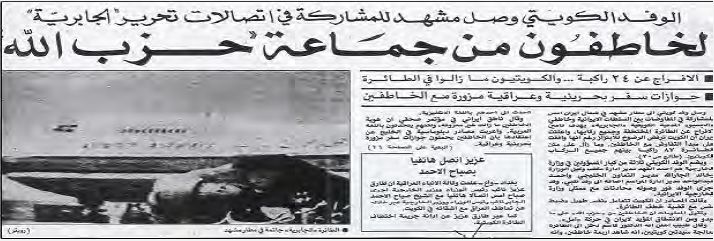
The (Lebanese) Hezbollah accused of cooperating with Iran to hijack the Kuwaiti plane (Al-Qabas, 1988)
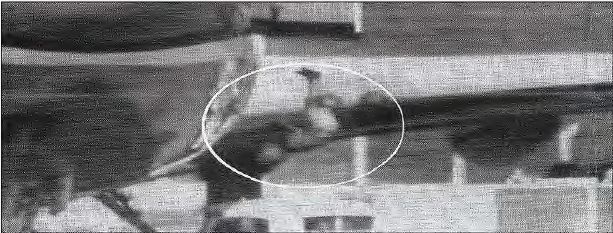
The body of a murdered passenger being dumped from the plane by the hijackers during a stop at Larnaka Airport in Cyprus (Hewarona.com website)
Hijacking Air France Planes (1983, 1984)
As part of the terrorist campaign against France, Hezbollah hijacked planes to use as bargaining chips for the release of Hezbollah operatives. Two Air France planes and one Air Afrique plane were hijacked for that purpose.
Details of the hijackings:
- On August 26, 1983, an Air France plane was hijacked out of Austria, apparently by Hezbollah operatives. They demanded the release of Lebanese prisoners held in France and the cessation of French military aid to Iraq, Lebanon and Chad.[61]
- On July 31, 1984, another Air France plane was hijacked en route from Frankfurt to France. It was forced to land in Iran, where it was blown up by the hijackers. An organization calling itself the Islamic Organization for the Liberation of Jerusalem (a pseudonym) claimed responsibility for the hijacking.
Hijacking an Air Afrique Plane (1987) and its Consequences
On July 24, 1987, an Air Afrique plane en route to the Congo was hijacked over Milan. The hijacker was Hezbollah operative Hossein Ali Mohammed Hariri, who demanded the release of his two brothers, terrorists held in West Germany (one of them on charges of involvement in the 1985 hijacking of the TWA plane). The hijacker also demanded the release of terrorists held in France (including Hezbollah operatives).
The hijacked plane landed at the Geneva airport to refuel, and a French passenger was shot dead by the hijacker during the stop. A stewardess who jumped on the hijacker was shot and wounded. Several hours later, the Swiss police took control of the plane and arrested the hijacker. The Iranians and Hezbollah attempted to pressure the Swiss into releasing him: in late July an explosive device blew up near the Swiss embassy in Beirut; in August an explosive device blew up in Geneva. Nevertheless, the hijacker was brought to trial and sentenced to life imprisonment.
True to form, Lebanese Hezbollah operatives abducted Swiss citizens in Lebanon as bargaining chips for the release of Hezbollah members held in Switzerland:
- November 17, 1988: Peter Winkler, a Swiss citizen and chief of the Red Cross office in southern Lebanon, was abducted in Lebanon by three armed gunmen about one month after his arrival in the country. The hijackers apparently intended to exchange him for Ali Mohammed Hariri, the hijacker of the Air Afrique plane who had been arrested by the Swiss authorities (deseretnews.com, November 18, 1988).
- October 6, 1989: two Swiss Red Cross workers, Emanuel Christen and Elio Erriquez, were abducted in Sidon. The hijackers demanded the release of the Air Afrique hijacker. The two men were freed on August 8 and 13, 1990 and transferred to Switzerland via Damascus (highbeam.com, August 9, 1990).
Iranian and Hezbollah Involvement in the Wave of Killings in Paris (1986-1987)
In the 1980s France was a preferred target for Iran and Hezbollah’s international campaign of terrorism. The anti-French wave of terrorism was manifested in various ways: bombing the multi-national force barracks in Beirut; attempting to bomb the French embassy in Kuwait; hijacking French planes; taking French hostages in Lebanon and launching a wave of terrorist attacks in France itself. The objectives were to stop French military assistance to Iraq, remove the French unit from the multi-national force in Lebanon, settle France’s debt to Iran and release detained terrorists — both from Hezbollah and other terrorist organizations — from prisons in France.
The terrorist campaign against France peaked in 1986, when three series of massmurder attacks were carried out in Paris by detonating explosive devices in crowded places. The terrorist attacks, which nearly paralyzed the city, took place in February, March and September, hitting commercial centers, intercity trains, the Paris Metro, the Champs Elysees, the Eiffel Tower and other public sites.[62] Eleven people were killed and over 220 injured in the attacks. Responsibility was claimed by an unknown network calling itself the Committee for Solidarity with Near Eastern Political Prisoners (CSPPA). However, some time later the French security services received information indicating that Iran and Hezbollah were involved in at least some of the 1986 attacks.
In early 1987 French security forces exposed a Shi’ite network headquartered in a Muslim school in a Parisian suburb, directed by Fouad Ben Ali Saleh (www.start.umd.edu). The members of the Hezbollah-affiliated network were detained in March 1987 as they were about to complete preparations for a new wave of terrorist attacks. Fouad Ben Ali Saleh, the network leader, was a Shi’ite Muslim of Tunisian extraction who was born in Paris and had French citizenship. In 1981-1982 he received military training in Iran while studying in the city of Qom. After his arrest, he announced that Iran was the bastion of Islam and that France was an “enemy” for helping Iraq fight Iran. He said that his main purpose was to use violence to make France “think clearly.”
The trial of Fouad Ben Ali Saleh, his wife and another operative in the network (a Lebanese driver) began on January 30, 1990. According to the French prosecution, the network worked for Hezbollah to force France to stop its assistance to Iraq during the Iran-Iraq War and free detained terrorists.[63] Fouad Ali Ben Saleh was sentenced to life and two of the network’s operatives were sentenced to twenty years in prison.
A second network was exposed in Paris in March-April 1987. Its operatives were affiliated with one of Hezbollah’s terrorist groups in Europe. It was exposed after the arrest of Hezbollah operatives in Italy and Germany in January 1987. The network’s operatives were involved in preparations for terrorist attacks and maintained contact with the Iranian embassy in Paris. In 1987 approximately sixty people were arrested on suspicion of involvement or membership in the terrorist network.[64] Two Lebanese nationals, Abbas Hawajeh and Mohammed Moussawi, were among those detained in Paris. According to the spokesman of the French interior minister, Moussawi had been in contact with the Iranian embassy in Paris (Los Angeles Times, July 26, 1987).
Fouad Ben Ali Saleh’s network was placed under surveillance, leading investigators to another suspect, Wahid Gordigi, who worked as an interpreter at the Iranian embassy in Paris. Gordigi was suspected of coordinating many of the terrorist operations carried out in 1986. The network he handled consisted of Tunisian, Lebanese and Armenian operatives, and carried out terrorist attacks in crowded places in Paris starting in February 1986.[65] Wahid Gordigi escaped to the Iranian embassy and was able to avoid being arrested. Iran, which argued that he had diplomatic immunity (even though he was not officially listed as a diplomat) gave him asylum and refused to extradite him (New York Times, July 3, 1987). French police forces then surrounded the Iranian embassy in Paris. In response, the Iranian police laid a siege to the French embassy in Tehran.[66]
The embassy sieges led to a crisis in France-Iran diplomatic relations. On July 16, 1987, Iran said it was reducing the staff of its Paris embassy and threatened to break off relations within 72 hours unless France stopped blockading the embassy and punished a policeman who had beaten an Iranian representative (Los Angeles Times, July 16, 1987). As a result, the diplomatic ties between Iran and France were severed that month. Hezbollah reacted by taking several French citizens hostage in Lebanon.[67]
The crisis ended in late 1987 and during 1988. Vahid Gordigi supposedly turned himself over to the French authorities, was questioned for two hours and put on a direct flight to Iran. In addition, France partially complied with Iran’s demand for the return of the loans it had received during the Shah’s regime (approximately $330 million out of $1 billion); Iranian opposition activists (particularly members of the Mojahedeen-e Khalq organization) were expelled from France. The measures led to the release of the last French hostages in Lebanon in May 1988. The diplomatic ties between Iran and France were reinstated on June 16, 1988, and their relations went back to normal.[68]
For Iran, Syria and Hezbollah, using terrorism as a weapon proved worthwhile in the case of France as well, even though the French authorities denied making any deals with Iran and Syria, which were behind Hezbollah’s campaign of terrorism.[69]
Prevention of Terrorist Activity in Germany (1987, 1989)
On January 13, 1987, Mohammed Ali Hammadi, a Hezbollah operative who had taken part in the 1985 hijacking of the TWA flight, was arrested in West Germany. He was caught trying to smuggle liquid explosives into Germany hidden in three large bottles of arak. During questioning he revealed the locations of large stockpiles of weapons near the French-German border. He was tried in Germany, convicted of the murder of the United States Navy diver during the hijacking of the TWA flight and sentenced to life imprisonment. Hezbollah responded by taking five German citizens hostage in Lebanon between 1987 and 1989. Eventually Mohammed Hammadi was pardoned, freed in 2005 and returned to Lebanon.
In March 1989 German security forces in the city of Darmstadt arrested Bassam Gharib Makki, a Hezbollah operative and student in Germany. In his possession were documents containing information on Israeli, Jewish and American sites in Germany that had been chosen as targets for terrorist attacks. He also had intelligence on British, French, Iraqi, Saudi and Kuwaiti sites that were being considered as potential targets. A search of his apartment revealed evidence linking him to terrorist activity, including instructions in Arabic for preparing and activating explosive devices.
Hezbollah Network Exposed in Spain (1989)
In November 1989 a Hezbollah cell was exposed in the city of Valencia. It consisted of several Hezbollah operatives and local collaborators. The cell was exposed after a large stockpile of weapons (including explosives and detonators) was found on board a ship that had arrived in Spain from Lebanon via Cyprus. The cell members were arrested and weapons were discovered in their homes. They admitted during questioning that they intended to use the weapons to carry out terrorist attacks against Israeli and American targets in Europe.
To read the first part of the full study, go here: Hezbollah: Portrait of a Terrorist Organization
To read Appendix I, go here: Hezbollah’s Terrorist Activity, 2000-2012
To read Appendix II, go here: Hezbollah’s Terrorist Activities during the 1990s
![]()
Notes:
[47] In February 1984 President Ronald Reagan announced the pullout of U.S. troops from Lebanon. His example was soon followed by France and Italy, the United States’ partners in the multi-national force in Lebanon.
[48] The FBI’s forensic laboratory called it the largest conventional explosion its experts had ever had to deal with (from an American Defense Department report published in the Marine Corps Gazette, February 1984).
[49] Shimon Shapira, Hezbollah between Iran and Lebanon (Hebrew) (Tel Aviv: Hakibbutz Hameuchad, 2000), pp. 165-167 and footnotes 109-111, p. 233. Shapira notes that the leaking of this sensitive intelligence information, intended to prove that the United States was aware who was behind the terrorist attacks against it, angered many of the United States intelligence community senior officials. He also notes that immediately after the information was published, Iran stopped exchanging communications between the Foreign Ministry in Tehran and its embassy in Damascus.
[50] Tim Weiner, Legacy of Ashes: The History of the CIA (New York: Doubleday, 2007), p. 391.
[51] Weiner, p. 393. According to Tim Weiner’s book, “the CIA came up with at least a dozen plans to free Buckley,” including kidnapping Imad Mughniyeh, but it never had enough intelligence to execute them.
[52] Ibid., pp. 390-391.
[53] The Hezbollah operative was found with explosives intended to be used in a bombing on the United States embassy in Rome.
[54] See also: Amine Gemayel, Al-Rihan al-Kabir (Arabic) (Beirut: Dar al-Nahar lil-Nashr, 1988), p. 123.
[55] This subsection is based on the decision issued by the U.S. court in the lawsuit filed by Malcolm Kerr’s family against the Islamic Republic of Iran.
[56] In the 1980s and 1990s, the MOIS was responsible for several terrorist attacks directed by Iran in various locations across the globe.
[57] Shapira, p. 167.
[58] Shapira, pp. 161-162.
[59] Kam, p. 265.
[60] Weiner, p. 401.
[61] Shaul Shay, Terror at the Command of the Imam (Hebrew), p. 75. At the time, France opposed the Libyan invasion of Chad. This led to tensions in France’s relations with the government of Libya, which also supported international terrorism.
[62] For a table listing the sites of the terrorist attacks in Paris, see Jeremy Shapiro and Bénédicte Suzan, “The French Experience of Counter-terrorism” (Survival, vol. 45, No. 1, Spring 2003).
[63] Shay, pp. 110-111.
[64] Ibid., p. 113.
[65] Kam, pp. 267-268.
[66] Shay, pp. 96-97, 112; www.pls.org, August 6, 2011.
[68] Shay, pp. 96-97, 112; Kam, p. 268 (Hebrew); pls.org, August 6, 2011.
[69] Shapiro and Suzan, “The French Experience.”



 RSS
RSS


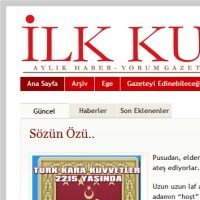
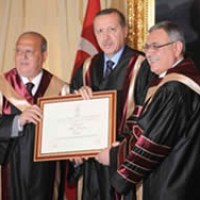

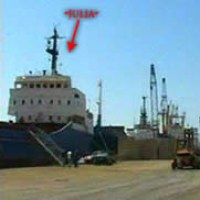
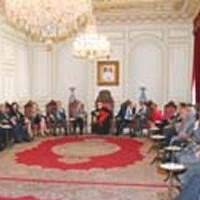




[…] To read Appendix III, go here: Hezbollah’s Terrorist Activities during the 1980s […]